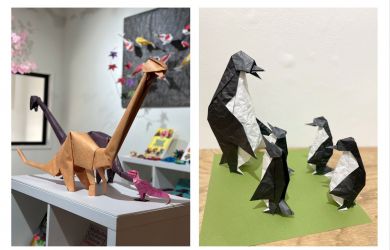
July 24, 2003
Into the Wild
John McGee plumbs the depths and scales the heights of Tohoku's grandest national park.
By Metropolis
Originally published on metropolis.co.jp on July 2003

Photos by John McGee
Tohoku is the hinterland of Honshu to most people, a vague uncharted territory north of Sendai. That perception is part of what makes it inviting-its natural beauty is less developed and relatively unsullied. The mountainous centerpiece of the region-and a hiker’s delight-is the disconnected halves of Towada-Hachimantai National Park.
The park’s combination of two volcanic lakes split by a broad sub-alpine plateau and a peppering of backwoods onsen was enough to entice me to sport my backpack and head into terra incognita.
My first stop was Towada-ko, a 327-meter-deep double crater lake straddling Aomori and Akita prefectures, and the Oirase Valley extending out of it. The Oirase River, currently featured on countless JR posters (okay, so it’s hardly unknown), flows out of the lake and rumbles through native mixed beech, maple and cedar forest, carving past mossy tree-topped islands along the way. Despite pouring rain, the fairly flat nine-kilometer (2-3 hours) trail between Nenokuchi and Ishigedo was undeniably pleasant. It bumps alongside the roiling waterway and passes waterfalls ranging from a slithering white thread to a 25m-high gusher. Unfortunately, a road also shares the narrow valley with the stream and path and, because this is a not-to-miss part of every tour bus itinerary, it was awfully busy.
Swimming upstream
The inside of a bus window is the closest many tourists get to Towada-ko so the lake area itself is fairly quiet. Cliffs fringed in native broadleaf forest frame the deep blue water in a summer mantle of green and autumnal oranges and reds. Of the several hotels, campgrounds and other options spread out along the roads, I settled on a minshuku in Yasumiya. This was not because Yasumiya is the larger and more pleasant of the two villages on the lake, but because it is the terminus for the infrequent JR buses; the bus I needed had stopped running for the day at 12:30pm, stranding me in limnologist limbo.

The next day I discovered Towada-ko’s best-kept secret-a sacred swimming hole. It’s only a few minutes walk beyond Yasumiya’s main shrine, on the far side of a peninsula jutting out into the lake. After climbing up a wooden stairway on one side of the hill, I descended the rocky cliff on the other via a rickety metal ladder. I stared at the lake’s cold, mystical water. May the gods curse me but, entranced, I slipped beneath the surface, past coins glittering on moss-covered boulders (a shrine?) and into its limpid depths.
Distant shore
Too bad bus routes lack the clarity of Towada-ko’s 10m visibility. To get to Towada-ko’s southern twin, Tazawa-ko (a direct shot back by highway), I had to select from a couple of complicated bus and train combinations. The best option was a bus through Hachimantai, a high plain where wooden planks lead through mists and scraggly forests, then by shinkansen from Morioka.
Tazawa-ko is a slightly smaller, rounder caldera lake which, at 424m, is Japan’s deepest. Swimming and boating are possible from its pebbly, sandy beaches too, but the main draw here is the spectacular views from the nearby hills.
The most popular trail is a four-hour roundtrip to a close-knit trio of Akita’s highest peaks in the Koma-ga-dake mountains a 45-minute bus ride east of Tazawa-ko. The trail starts above tree line and winds up through waist-high bamboo grass and meadows strewn with yellow wildflowers to a small pond, Amida-ike, in a depression between the peaks. The 1600m summits give slight variations on views over Tazawa-ko, down to the grassy bowl of the miniature volcanic neighbor, Ko-dake, and to distant farmland. From the pond, trails branch off in all directions.

The view north proved irresistible and I set off along a wide crested alpine ridge stretching out to Nyuto-san (“breast mountain,” due to its profile) before dropping into the hot spring hamlet of Nyuto Onsen 13km (7-10 hours) away. Mostly it was an easy up and down ramble through deliciously lonely and utterly shadeless bamboo grass. The unforgettable parts came when the trail dipped, passing through the stunted conifers sprouting from the sub-alpine marshes and scattered tarns of Sensho-ga-hara and Tashirotai.
After a long slippery descent through the native forest below Nyuto-san, I began to see tiny onsen hotels tacked to the slopes. I was looking for the quaint thatched roof cottages-former samurai quarters-of Tsuru-no-yu. Alas, by the time I found it at the end of a dirt road in a private valley, it was too late for visitors to slide into the milky blue water of its rotenburo.
It was also too late for the bus, so I hitched a ride back to town for a golden sunset splash in Tazawa-ko. Later I pondered the future of the region-ever more accessible via JR’s ongoing shinkansen extensions-while watching a forklift yank swan boats from the water.
Getting there
For Towada-ko, take the Tohoku shinkansen from Tokyo to Hachinohe (¥15,350 o/w, about 3hr) then transfer to a JR bus (¥2600 o/w, 2-1/4hr, 3 buses/day) bound for Towada-ko. The Oirase Valley is between the hamlets of Nenokuchi (on the lake) and Yakeyama. A public bus connects them and stops at regular intervals between. Bicycles are also available for rent. Besides a bus, a boat connects Nenokuchi with the other lakeside town of Yasumiya.

Reach Tazawa-ko by taking the Akita shinkansen to Tazawa-ko station (¥15,240 o/w, 3-1/2hr) and transfer to a local bus. Buses to and from the Tazawa-ko hikes and Nyuto Onsen have extremely restricted schedules so be sure to check in advance and start early. There’s no direct transport link between the two lakes, but there are bus and bus-train combinations that will get you there. You might want to consider two ongoing JR ticket promotions. Futari no Kita-Tohoku Free Kippu ticket costs ¥44,000 for two people and allows non-stop shinkansen travel to Morioka and unrestricted passage on all JR trains buses (by reservation) from there north within any four-day period. The Three-Day Weekend pass (¥24,000) allows travel on JR East trains (including the shinkansen but not buses) until September 1. Travel must start on a Friday or Saturday.
Where to stay
In Yasumiya, Towada-ko, there are several reasonably priced minshuku within a few minutes walk of the town center. The tourist information office next to the town’s bus station can provide details (tel: 0176-75-2425). Budget travelers to Tazawa-ko usually stay at the rambling old youth hostel (¥4820 w/two meals, tel: 0187-43-1281) about a block from the water. The town also has numerous pensions and minshuku. The modern information center, inside the Tazawa-ko shinkansen stop, is an excellent resource (tel: 0187-43-2111). Tsuru-no-yu requires reservations as it is often booked months in advance (tel: 0187-46-2139). Visitors are allowed, but only from 10am-3pm.
[geo_mashup_map]







